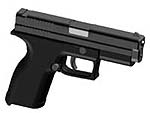MICROPHONE, NOTEBOOK.....FIREARM?

Baghdad-based New York Times reporter Dexter Filkins crosses a fundamental line if this article is correct.
The report claims that Filkins has made a habit of carrying a gun on assignment.
This is simply unacceptable.
While the desire for a journalist to carry a weapon for self-protection in a dangerous environment is understandable, especially given the increasing frequency with which journalists are being killed, it cannot be condoned under any circumstances. It blurs the line between observer and participant in a war zone -- and leaves journalists vulnerable to attack.
As the Committee to Protect Journalists explains:
"Journalists covering conflicts should never carry arms or travel with other journalists who carry weapons. Doing so jeopardizes a journalist's status as a neutral observer and can make combatants view correspondents as legitimate military targets" (Source: On Assignment -- A Guide to Reporting in Dangerous Situations)
In the most notorious incident, Fox News crackpot Geraldo Rivera rightly earned widespread condemnation for packing a pistol in Afghanistan. Live on air, Rivera bragged that "If they're going to get us, it's going to be in a gunfight."
While it's easy to dismiss Rivera's actions as those of a crazed loon (whose death in a gunfight would be a relief to most journalists), the implications of his idiocy are extremely serious.
Steve Bell, who covered the Vietnam War for ABC, was captured by the Viet Cong in 1970 and had to persuade the soldiers that he wasn't a CIA agent. "If I had been carrying a weapon, I doubt if that argument would have gone over well," Bell says.
While working in Iraq, I twice had to confront the issue. A Kurdish driver I hired insisted on carrying a Kalashnikov in the boot of the vehicle and a pistol on his hip. He was quickly dismissed. In another incident, I visited an army barracks, only to find that the Peshmerga soldiers had taken a pick-up truck with a heavy machine gun mounted on the back and written the words "TV" in large red letters on the sides -- the idea being that enemy forces would think they were reporters rather than combatants and leave the vehicle alone. Through my translator I explained to the commander that this was unacceptable. Thankfully, he agreed to remove the signs.
In an increasingly competitive and dangerous media environment, Washington Post Baghdad Bureau Chief Rajiv Chandrasekaran adopts a safety policy that should be followed by every journalist and media organisation in every hostile environment -- "If you feel you need a gun to cover a story, then you shouldn't be doing the story," he says.

Baghdad-based New York Times reporter Dexter Filkins crosses a fundamental line if this article is correct.
The report claims that Filkins has made a habit of carrying a gun on assignment.
This is simply unacceptable.
While the desire for a journalist to carry a weapon for self-protection in a dangerous environment is understandable, especially given the increasing frequency with which journalists are being killed, it cannot be condoned under any circumstances. It blurs the line between observer and participant in a war zone -- and leaves journalists vulnerable to attack.
As the Committee to Protect Journalists explains:
"Journalists covering conflicts should never carry arms or travel with other journalists who carry weapons. Doing so jeopardizes a journalist's status as a neutral observer and can make combatants view correspondents as legitimate military targets" (Source: On Assignment -- A Guide to Reporting in Dangerous Situations)
In the most notorious incident, Fox News crackpot Geraldo Rivera rightly earned widespread condemnation for packing a pistol in Afghanistan. Live on air, Rivera bragged that "If they're going to get us, it's going to be in a gunfight."
While it's easy to dismiss Rivera's actions as those of a crazed loon (whose death in a gunfight would be a relief to most journalists), the implications of his idiocy are extremely serious.
Steve Bell, who covered the Vietnam War for ABC, was captured by the Viet Cong in 1970 and had to persuade the soldiers that he wasn't a CIA agent. "If I had been carrying a weapon, I doubt if that argument would have gone over well," Bell says.
While working in Iraq, I twice had to confront the issue. A Kurdish driver I hired insisted on carrying a Kalashnikov in the boot of the vehicle and a pistol on his hip. He was quickly dismissed. In another incident, I visited an army barracks, only to find that the Peshmerga soldiers had taken a pick-up truck with a heavy machine gun mounted on the back and written the words "TV" in large red letters on the sides -- the idea being that enemy forces would think they were reporters rather than combatants and leave the vehicle alone. Through my translator I explained to the commander that this was unacceptable. Thankfully, he agreed to remove the signs.
In an increasingly competitive and dangerous media environment, Washington Post Baghdad Bureau Chief Rajiv Chandrasekaran adopts a safety policy that should be followed by every journalist and media organisation in every hostile environment -- "If you feel you need a gun to cover a story, then you shouldn't be doing the story," he says.

0 Comments:
Post a Comment
<< Home